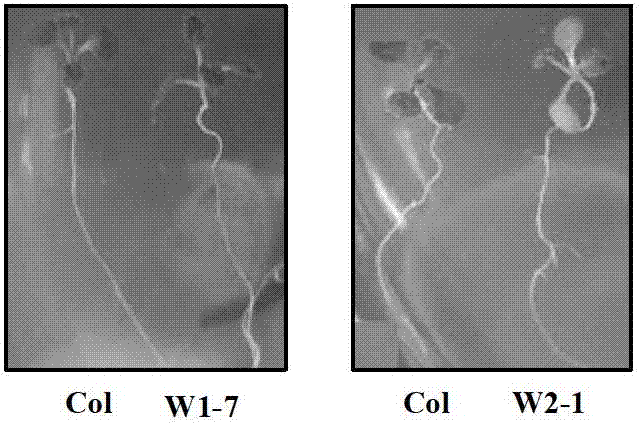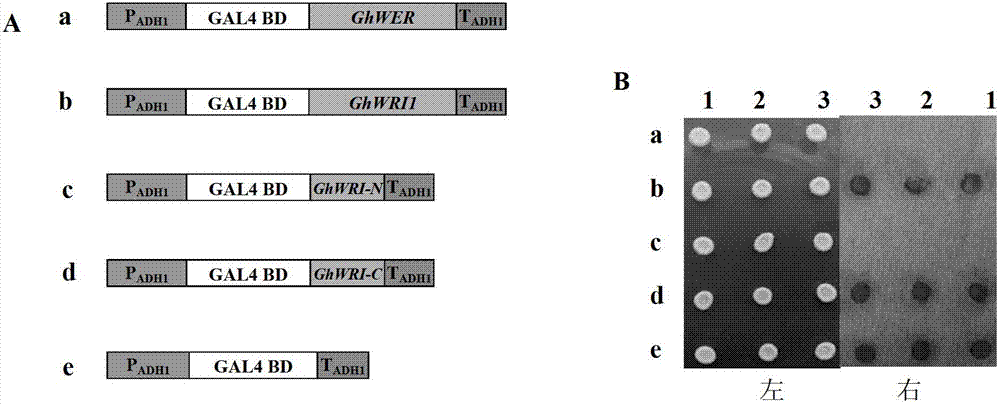Transcription factor for improving plant seed aliphatic acid content and application thereof
A technology of plant seeds and fatty acids, applied in the direction of plant genetic improvement, application, plant peptides, etc., to achieve the effect of increasing the content of fatty acids in seeds
- Summary
- Abstract
- Description
- Claims
- Application Information
AI Technical Summary
Problems solved by technology
Method used
Image
Examples
Embodiment 1
[0083] Embodiment 1, the acquisition of the coding gene GhWRI1 of cotton transcription factor GhWRI1
[0084] 1. Total RNA extraction: Upland cotton (Gossypium hirsutum L.) variety Coker201 (Wu Xiuming, Liu Chuanliang, Zhang Chaojun, Li Fuguang. Research progress in cotton somatic embryogenesis. Bulletin of Botany, 2008,25(4):469-475 ) as the experimental material, the immature embryo material 20 days after flowering was taken, quick-frozen in liquid nitrogen, and CTAB method was applied (references: Liu Yang, He Xinyao, Ma Hongbo, Wu Yongli, Yang Youming. The total RNA of each tissue of cotton was extracted by CTAB-PVP method Research. Journal of China Agricultural University, 2006, 11(1):53-56) to extract RNA.
[0085] 2. Use Promaga's RT-PCR reaction system to reverse transcribe the RNA extracted in step 1 to synthesize cDNA.
[0086] 3. RT-PCR amplification:
[0087] According to the EST information of cotton in the NCBI database, spliced into contig, the following prime...
Embodiment 2
[0095] Example 2, Functional Analysis of Transcription Activation of GhWRI1 Transcription Factor
[0096] In this example, pGBT9 (Meng Hongyan, Du Xiongming, Zhang Chunyi, etc. Cloning of cotton transcription factor gene GhMS3 and identification of its promoter function. Chinese Agricultural Sciences, 2010, 43 (17)) was used as the original vector to construct the following three expression vectors ( figure 2 Middle A): (1) Recombinant expression vector pGBT-GhWRI1 containing the full-length CDS of the GhWRI1 gene (sequence 1, referred to as GhWRI1-CDS); (2) containing the N-terminal of the GhWRI1 gene (1-654 core (GhWRI1-N for short) recombinant expression vector pGBT-GhWRI1-N; (3) recombinant expression vector pGBT containing the C-terminal of the GhWRI1 gene (nucleotides 661-1317 of sequence 1, GhWRI1-C for short) -GhWRI1-C. In order to analyze the transcription activation function of GhWRI1 transcription factor.
[0097] 1. Construction of recombinant expression vector...
Embodiment 3
[0112] Embodiment 3, expression analysis of GhWRI1 gene
[0113] Upland cotton (Gossypium hirsutum L.) varieties 09F9083, 09F9077, 09F9077, 09E1021 and 09E1022 with different oil contents were extracted (all varieties were purchased from Hebei Jifeng Seed Industry Co., Ltd.; the oil content of seeds was extracted by Soxhlet The results are shown in Table 1) The RNA of immature embryos 20 days after flowering was reverse-transcribed into cDNA by Promaga's RT-PCR reaction system, and the primer 5'-GGCATAGATGGACTGGGAGAT-3' (the 251st part of Sequence 1) was designed for the GhWRI1 gene -271 position) and 5'-GCTGCTGCTTCCTCTTGTGT-3' (reverse complementary sequence of positions 637-656 of Sequence 1), Ghactin was used as an internal reference gene, and primers 5'-ATCCTCCGTCTTGACCTTG-3' and 5'-TGTCCGTCAGGCAACTCAT-3 were designed ', using semi-quantitative RT-PCR to analyze the expression of GhWRI1 gene in oily materials.
[0114] The result is as Figure 4 As shown, the expression ...
PUM
| Property | Measurement | Unit |
|---|---|---|
| Molecular weight | aaaaa | aaaaa |
Abstract
Description
Claims
Application Information
 Login to View More
Login to View More - R&D
- Intellectual Property
- Life Sciences
- Materials
- Tech Scout
- Unparalleled Data Quality
- Higher Quality Content
- 60% Fewer Hallucinations
Browse by: Latest US Patents, China's latest patents, Technical Efficacy Thesaurus, Application Domain, Technology Topic, Popular Technical Reports.
© 2025 PatSnap. All rights reserved.Legal|Privacy policy|Modern Slavery Act Transparency Statement|Sitemap|About US| Contact US: help@patsnap.com



